Elongate
Facts, identification & control
Latin name: Pseudomyrmex gracilis
Overview
The adult ants are slender, 8 – 10 mm in length. When we view from above, they look like wasps without wings. Their colors are very various, commonly range from the mixture of dark brown – black to orange – brown. Their head and abdomen are dark color while their thorax is light orange in color. Pseudomyrmex gracilis bites very painful but it is not aggressive as red fire ant. Read more red fire ant.
Activity, food, habit
These ants commonly build their nest in hollowed – out cavities of plant material like dead twigs and small branches. Their nests are quite small and only have a queen. Some of more popular environments are rainforests, mangrove, some ancillary plants and hardwood trees. Their nests have only one small entrance and may be inhabited by a few ants. Elongate twig ants dig nesting cavities themselves if nesting materials are flexible and they also nest in tunnels which were made by the beetles.
Elongate twig ants do not create pheromones to aid in nest relocation. The adult worker will take other workers, queens and males to new nest if they want to move or build a new nest.
Elongate twig ants commonly do not attack to ornamental plants and structures but sometimes they are found in wood doors inside the house.
Pseudomyrmex gracilis move and attack their nest invaders. This habit is very important because elongate twig ants are considered as useful insects, they kill pests to protect their nest. Different from others, elongate twig ants are independent hunters.
Reproduction

Reproduction begins when a virgin queen emerges its nest to mate with a male reproductive. After mating, the queen starts building new nest by laying eggs and tending the brood. When the first group of workers grows, they take responsibility for taking care of the nest and find the food, the queen takes responsibility for laying eggs.
Sign of infestation
Appearance of stinging ants and flying ants fly everywhere to reproduce are signs of infestation.


